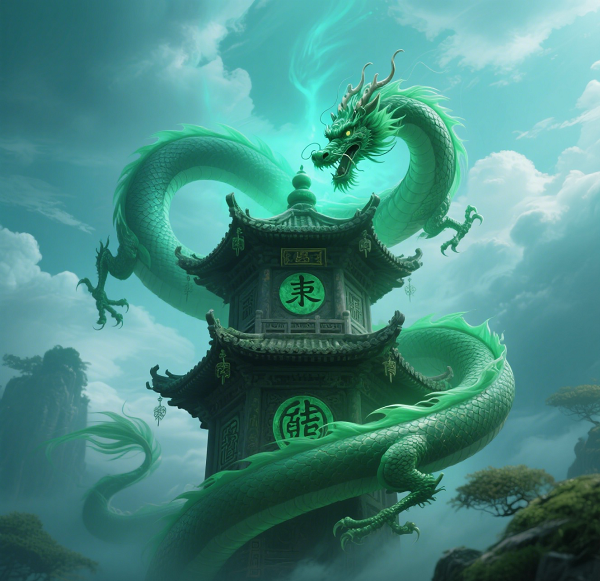Beautiful Plants For Your Interior

I. Introduction: Unveiling the Mythical Power of the Dragon
- A. The Dragon’s Iconic Status: More than just a mythical creature; a symbol deeply embedded in Chinese culture and philosophy.
- B. The Dragon in Feng Shui: Its profound significance in creating auspicious and harmonious environments.
- C. Overview: Exploring the dragon’s symbolism, its role in energy flow, and how to harness its power in your space.
II. The Dragon in Chinese Mythology and Culture
A. Supreme Symbol of Power and Good Fortune
- 1. Imperial Association: Historically linked to emperors, representing divine power, authority, and prosperity.
- 2. Benevolent Creature: Unlike Western dragons, Chinese dragons are typically wise, kind, and bring good luck and rain.
B. Control over Elements and Phenomena
- Associated with water (rain, rivers, oceans) and weather (storms, clouds).
- Guardians of treasure and bringers of fertility.
III. The Dragon’s Role and Meaning in Feng Shui
A. The Green Dragon (Qīng Lóng): The Auspicious Side
- Represents male energy, protection, wealth, health, and authority.
- Often paired with the White Tiger (Bái Hǔ) for balance.
B. Chi (Qi) Flow and Dragon Veins (Lóng Mài)
- 1. Dragon Veins: Metaphorical energy lines (ridges, mountains) through which Earth’s Chi flows.
- 2. Activating Chi: The presence of a dragon symbol or feature can activate positive Chi in a space.
C. Guardianship and Protection
- A powerful protector against negative energy (Sha Chi).
- Symbolizes vigilance and defense.
D. Growth, Success, and Opportunity
- Embodies ambition, courage, and the drive for success.
- Can symbolize new beginnings and personal development.
IV. Integrating Dragon Energy in Feng Shui Spaces
A. Strategic Placement: Where Dragons Thrive
The direction and area for placing dragon symbols are crucial.
- East Sector:
- Traditionally the most potent direction for the Green Dragon.
- Associated with health, family, and new beginnings (Wood element).
- Living Room/Office:
- Ideal for activating career success, wealth, and authority.
- Ensure placement is respectful and not overly dominant.
- Back of the House/Property:
- For large properties, the “dragon’s back” refers to protective mountain ranges or higher ground behind the home.
B. Forms of Dragon Representation
Dragons can be incorporated in various forms, each with unique characteristics.
| Form of Dragon | Description & Best Use | Notes/Considerations |
|---|---|---|
| Statues/Figurines | Solid representations, often made of wood, metal, ceramic. Best for visible placement. | Avoid placing too high (above eye level) or facing a toilet/bathroom. Always ensure they face inwards. |
| Artwork/Paintings | Dragon imagery in paintings, tapestries. Can be subtle or prominent. | Choose artwork that depicts a benevolent, ascending dragon. Avoid angry or descending dragons. |
| Natural Landforms | Subtle “dragon energy” from rolling hills, winding rivers, or curved paths. | Requires understanding of landscape Feng Shui; often applies to property selection. |
| Symbols/Patterns | Dragon motifs on fabrics, ceramics, architectural details. | Less potent than 3D forms, but still contributes positive energy. |
C. Do’s and Don’ts for Dragon Placement
- Do:
- Place the dragon in the East sector.
- Ensure the dragon faces *into* the home or space, never out.
- Place it on the left side of the room/property when looking out from the main entrance (Green Dragon’s position relative to the White Tiger).
- Pair with a White Tiger for balance (the Tiger should be lower than the Dragon).
- Keep the area around the dragon clean and uncluttered.
- Don’t:
- Place dragons in bedrooms (can be too much active Yang energy for rest).
- Place dragons directly facing toilets, bathrooms, or messy areas.
- Place dragons higher than the head of the oldest family member (symbolically overpowering).
- Use too many dragon symbols in one space; quality over quantity.
- Use dragons with aggressive or angry expressions.
V. Conclusion: Empowering Your Space with Dragon Energy
- A. Recap the Dragon’s Essence: A powerful, benevolent symbol of protection, wealth, and positive Chi.
- B. Thoughtful Integration: Emphasize strategic placement and respectful representation.
- C. Final Thought: By understanding and honoring the dragon’s meaning, you can invite auspicious energy and enhance the harmony and prosperity of your Feng Shui space.

